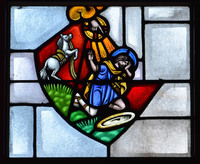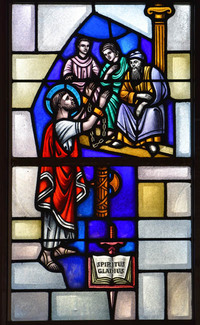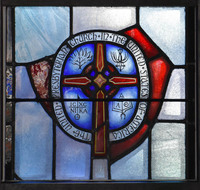Window
Building Name: St. Paul's Presbyterian ChurchStudio Name: Willet Hauser Architectural Glass
City: Livonia
Window Shape: 2 (rectangle)
Date of Window: 1965
Subject/Title of Window: Saul’s Conversion/Paul’s Defense/Church Seal
Brief Description of Subject: Originally the west nave wall was designed for a two panel window, however after about 40 years, the entire wall was replaced with clear glass to let more light into the Church. No longer constrained by the original architecture, the two panels of each of the original windows were separated and reinstalled singularly, evenly spaced out across the west wall. In the process of reassembling this window, the wrong bottom section was put in. Instead of the scene with Paul watching the stoning of Stephen, it now has the Seal in the United Presbyterian Church of the USA which previously was the bottom section of the window called "The Modern Church." As now seen the top three sections of this window were designed by Marguerite Gaudin while the bottom section was designed by Eric Sundean.
Upper Scene: Saul's conversion is found in Acts 9. Saul had obtained letters from the high priest to travel to Damascus and arrest any Christians he found, and bring them to Jerusalem. This scene is based on Verses 3 -8 (paraphrasing) As he neared Damascus, a light from heaven blinded him and he was knocked off his horse, and fell to the ground. A voice asked him, "Why do you persecute me?" Saul wondered, "Who said this?" The voice answered "I am Jesus the one you persecute, now get up and go to Damascus and await my instructions."
Middle Scene: Paul's defense before Festus and Agrippa is found in Acts 26. Paul was arrested in Jerusalem but when it became known he was a Roman citizen, he was sent to Caesarea to be tried by the governor named Felix. Felix imprisoned him for two years before being replaced with Festus. Festus wanted to send Paul back to Jerusalem but as a Roman citizen, Paul demanded his right to plead his case before the Emperor. A few days later King Agrippa II and his sister Bernice arrived for a visit. When he heard about Paul, he told Festus that he would like to hear the man himself. The next day Paul stood before Festus, Agrippa and Bernice to state his case. Festus thought he was crazy but Agrippa was impressed by Paul and thought he should be freed. Since he had appealed to be heard by the Emperor, it was decided to send him to Rome. This scene pictures a chained Paul, standing before Festus, Agrippa and Bernice, pleading his case. To the right of Paul is seen a "fasces" (displayed by Roman magistrates as a symbol of their power). At the bottom appears a symbol of Paul --- a sword with a book inscribed with the words "Spiritus Gladius" (Sword of the Spirit). This comes from Paul's letter to the Ephesians 6:17 --- "Take the helmet of salvation, and the sword of the spirit, which is the word of God." (NIV)
Lower Scene: Seal of the United Presbyterian Church in the United States of America. Bordered by the name of the organization, the dominate feature of their seal is a Celtic Cross which divides the area into four quadrants, each of which contains a Christian symbol:
Burning Bush: A symbol of the Protestant Church. This most likely had its origin from a comment by John Calvin that the burning bush that Moses saw that was not consumed to ashes is like the Protestant Church which is subjected to the fires of persecution but as Christ has promised in Matthew 16:18 "My Church will not be overcome by the fires of Hades."
Descending Dove: A symbol of the Holy Spirit. This comes from Mark 1:10, at Jesus' baptism "the Spirit descending on him like a dove."
Bible with Monograms. The authority of the Bible is one of the central tenets of the Presbyterian faith. The Greek capital letters "Alpha" and "Omega" symbolize God --- Revelation 1:8 God said, "I am the Alpha and the Omega. the beginning and the end." The Greek capital letters "Lambda" and "Theta" is a monogram for "Word of God" --- the first Greeks letters from the Greeks words "Logo" (word) and Theos (God).
Globus Cruciger with phrase" Jesus Christ Conquers." The Globus Cruciger (orb with cross) is the symbol for "authority." In the quadrants of the cross are the Greek capital letters, "IC" (first two letters of the Greek word for "Jesus'), "XC" (first two letters for the Greek word for "Christ'), and "NIKA" (Greek word for "conquers").
Note: The United Presbyterian Church in the United States of America no longer exists as it merged with the Presbyterian Church USA in 1983, so that this seal is no longer used.
Inscriptions: Spiritus Gladius
The United Presbyterian Church in the United States of America
IC
XC
NI
KA
Condition of Window: Good
Height: 88"
Width: 24"
Type of Glass and Technique: Opalescent Glass, Lead Came
Saul’s Converstion/Paul’s Defense/Church Seal
Saul’s Converstion
Paul's Defense
Seal of the United Presbyterian Church in the United States of America
Saul’s Converstion/Paul’s Defense/Church Seal Willet sketch
The MSGC is a constantly evolving database. Not all the data that has been collected by volunteers has been sorted and entered. Not every building has been completely documented.
All images in the Index are either born-digital photographs of windows or buildings or are scans of slides, prints, or other published sources. These images have been provided by volunteers and the quality of the material varies widely.
If you have any questions, additions or corrections, or think you can provide better images and are willing to share them, please contact donald20@msu.edu







